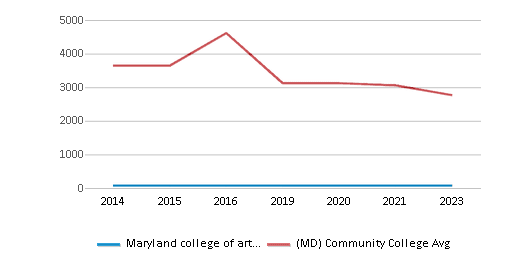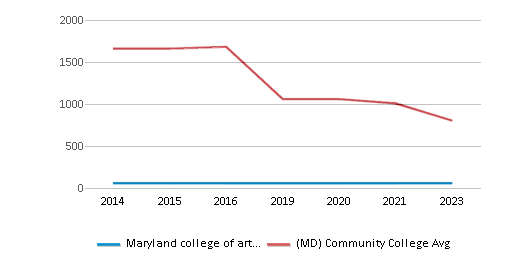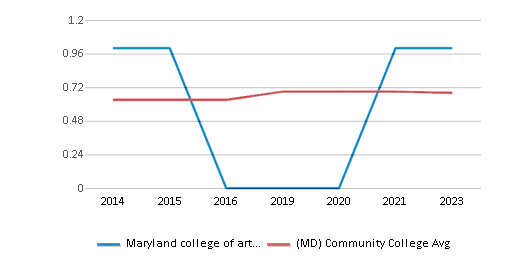- The School of Art and Design, through the award of the Associate of Fine Arts degree and the continuing education program, is committed to teaching and learning through an intensive, structured, and sequential program of studio arts and general education, and through enrichment classes. SA+D assists you in the development of your artistic ability at your individual level of aesthetic understanding and technical skill. The School's programs are designed to give degree and enrichment students a wide range of opportunities to grow in awareness and skills to continue their art education at a higher level, to pursue a career in an arts related field, or to continue creating art as an avocation. The School of Art and Design stresses a life time commitment to developing the gift of creativity and sharing that gift with others in an always expanding community.
School Highlights
Maryland college of art and design serves 78 students
Minority enrollment is 100% of the student body (majority Black and Hispanic), which is less than the state average of 63%.
Quick Stats (2025)
- Enrollment: 78 students
- Source: Integrated Postsecondary Education Data System (IPEDS)
Top Rankings
Maryland college of art and design ranks among the top 20% of public schools in Maryland for:
Category
Attribute
School Overview
Maryland college of art and design
(MD) Community College Avg.
Carnegie Classification
Associate of Arts Colleges
Associate's Colleges: Mixed Transfer/Career & Technical-High Traditional
Institution Level
At least 2 yrs but < 4 yrs
At least 2 but less than 4 years
Institution Control
Private, non-profit
Public
Total Faculty
n/a
378 staff
Student Body
The student population of Maryland college of art and design has stayed relatively flat over five years.
The Maryland college of art and design diversity score of 1.00 is more than the state average of 0.75. The school's diversity has stayed relatively flat over five years.
Total Enrollment
78 students
3,998 students

Student : Teacher Ratio
n/a
12:1
# Full-Time Students
n/a
985 students
# Part-Time Students
n/a
3,409 students
# Enrollment Undergraduate
n/a
243 students
# Full-Time Undergraduate Students
58 students
985 students

# Full-Time Graduate Students
n/a
19 students
# Part-Time Undergraduate Students
n/a
4,482 students
% Asian
n/a
7%
% Hispanic
n/a
13%
% Black
n/a
30%
% White
n/a
37%
% Two or more races
n/a
5%
% Non Resident races
n/a
5%
% Unknown races
100%
3%
Diversity Score
n/a
0.75

College Completion Rate (Students who graduate in less than 4 years)
n/a
0.2841%
Tuition and Acceptance Rate
% Students Receiving Some Financial Aid
n/a
72%
Median Debt for Graduates
n/a
$10,000
Median Debt for Dropouts
n/a
$5,500
Acceptance Rate
n/a
100%
Source: 2023 (or latest year available) Integrated Postsecondary Education Data System (IPEDS) , School Administrators
School Notes
- The School of Art and Design at Montgomery College (SA+D) began in 1957 as Maryland College of Art and Design. It continues today as a community of artists providing education – the AFA degree and non-degree courses - in the visual arts to residents of the surrounding area. The institution grew from an informal arts center to a professional, accredited, degree-granting college and then to join Montgomery College in 2004, without changing the supportive environment that makes this educational institution unique. As a community of artists — students and professionals — working together, all of us here at SA+D are committed to helping one another advance toward our individual career, educational, and artistic goals.This spirit of cooperation and support has been a hallmark of this art school experience for over 47 years. The School of Art and Design at Montgomery College is perfect for you if you are looking for an art school experience—a structured studio intensive program for art majors who are committed to studying art and planning to transfer to a four-year art institution. The School of Art and Design courses and program are located at 10500 Georgia Avenue in Silver Spring, Maryland. This artists' community environment includes studio classrooms, faculty offices, and student lounge within the same building. In addition to drawing, painting and design studios, our facilities also include a black and white photography lab and two fully equipped G5 Macintosh computer graphics labs with industry-standard hardware and software, including Quark XPress, Dreamweaver, Flash, Illustrator, and Photoshop. Our facilities also include display areas for ongoing student work, a library, a career/transfer center and a professional artists' gallery which displays the work of local and regionally known artists. The close proximity of these components within the same building encourages conversation about art, education, and life among the students, faculty, and staff. Our small size and our focus on maintaining a collaborative learning community encourage enthusiastic and serious artistic growth. This is an environment where you'll have the opportunity to concentrate on developing and refining your individual creativity and talents, have easy access to your teachers, and form close and lasting relationships with other members of the School of Art and Design community: a diverse and dedicated group of individuals who all share your interest in art.
Frequently Asked Questions
What is Maryland college of art and design's ranking?
Maryland college of art and design ranks among the top 20% of community college in Maryland for: Average community college minority breakdown.
In what neighborhood is Maryland college of art and design located?
Maryland college of art and design is located in the Wheaton neighborhood of Silver Spring, MD.
Recent Articles

Obtaining Your Bachelor's Degree at a Community College
Explore the evolving landscape of community colleges offering bachelor's degrees, addressing affordability, accessibility, and workforce needs.

A to Z of Community College Certificates and Courses
From business and healthcare to technology and skilled trades, the article showcases the breadth of options available to students seeking to enhance their knowledge, develop new skills, or pursue career advancement.

What is a Community College?
This comprehensive guide explains what a community college is, its history, and its role in higher education. It covers the types of programs offered, differences from four-year colleges, benefits of attending, and important considerations for prospective students, providing valuable insights for those exploring educational options.





